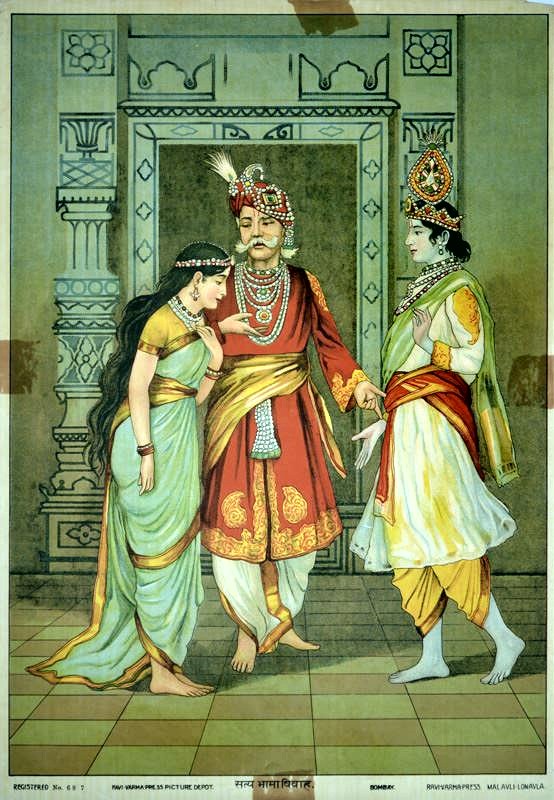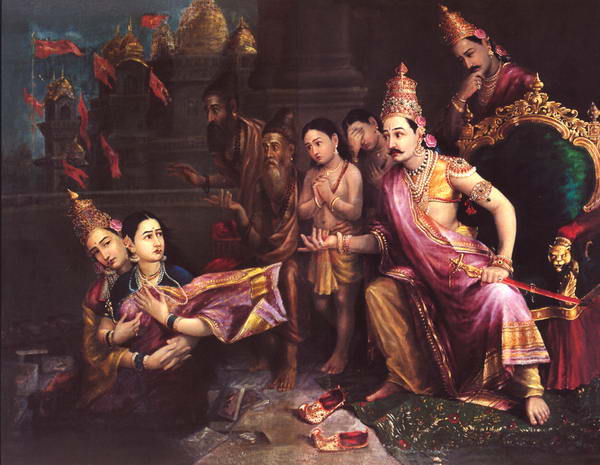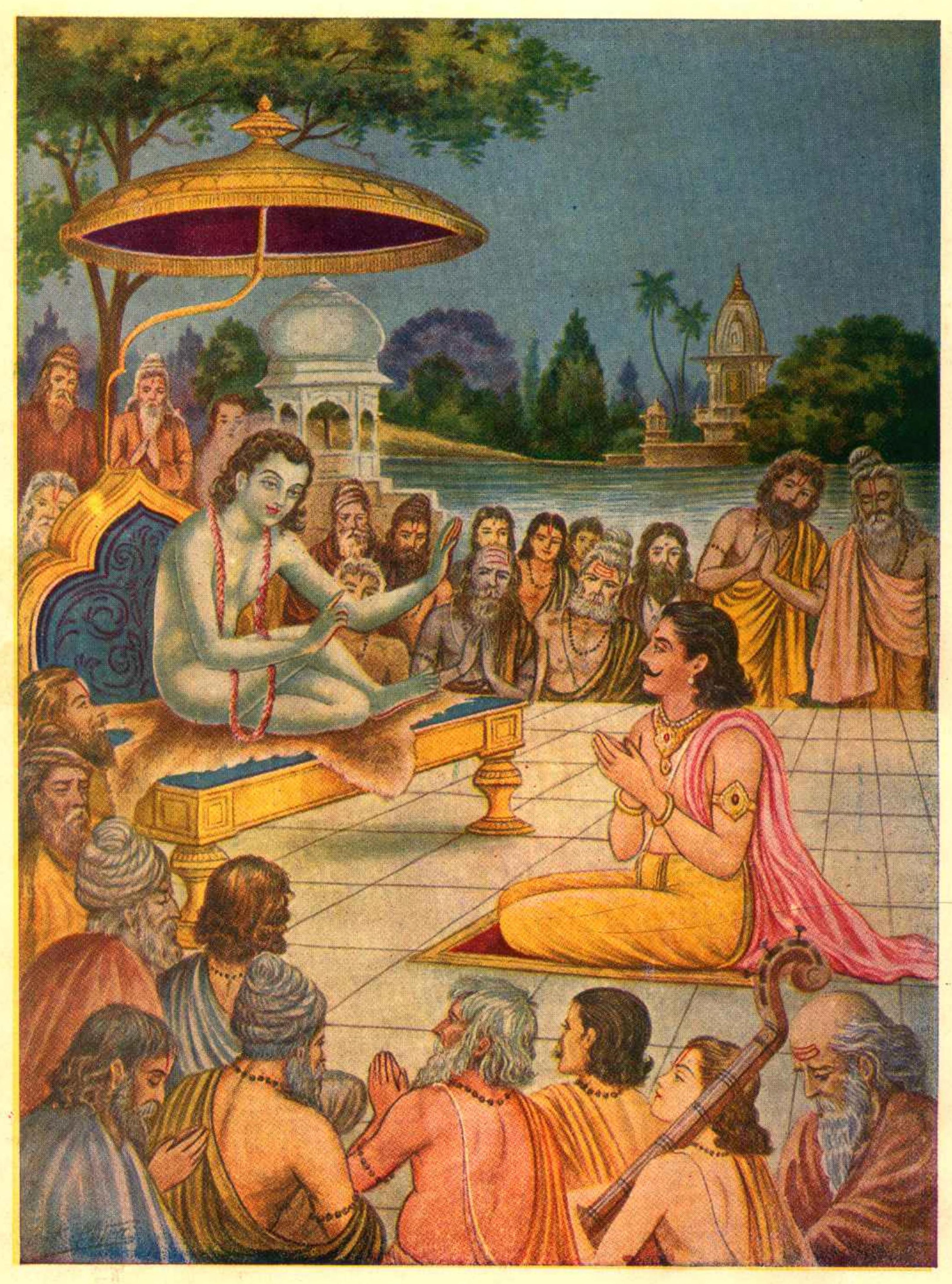|
Narakasur
Naraka, also known as Narakāsura, and Bhaumāsura was an asura king, the legendary progenitor of all three dynasties of Pragjyotisha-Kamarupa, and the founding ruler of the legendary Bhauma dynasty of Pragjyotisha. Though the myths about Naraka are first mentioned in the Mahabharata, later texts embellish them. According to later post-Vedic texts such as the Brahma Purana and Vishnu Purana, he was the son of Bhudevi, fathered by the Varaha incarnation of Vishnu. He is claimed as one who established Pragjyotisha. He was slain by Krishna and Satyabhama. His son Bhagadatta—of Mahabharata fame—succeeded him. The 10th/11th-century Kalika Purana embellishes the myths further and he is claimed to have come from Mithila and said to have established the kingdom of Pragjyotisha after overthrowing the last of the Kirata kings, Ghatakasura, of the Danava dynasty. It was foretold that he would be destroyed by a later incarnation of Vishnu. His mother, the earth, sought the boon ... [...More Info...] [...Related Items...] OR: [Wikipedia] [Google] [Baidu] |
Kamakhya
Kamakhya (), a mother goddess, is a Shakta Tantric deity; considered to be the embodiment of '' Kama (desire)'', she is regarded as the goddess of desire. Her abodeKamakhya Temple is located in the Kamarupa region of Assam, India."Seated on top of Nīlacala hill on the banks of the Brahmaputra river in the state of Assam, Northeast India, Kamakhya temple is one of the oldest and most revered centres of Tantric practice in South Asia. Since at least the eighth century, the region of Kamarupa (the ‘place’ or ‘form of desire’, or Assam) has been recognised as one of the most important of the sakta pīthas (‘seats of power’) or centres of goddess worship that dot the sacred landscape of India, Pakistan and Bangladesh." Originally a Kirata goddess, Residing on Nilachal hills across the banks of the Brahmaputra River, west of Guwahati in the 10th/11th century Temple rebuilt in 1565 CE, she is worshiped in a non-iconic and un-anthropomorphic form of stone shaped like y ... [...More Info...] [...Related Items...] OR: [Wikipedia] [Google] [Baidu] |
Satyabhama
Satyabhama (IAST'': Satyabhāmā)'' , also known as Satrajiti, is a Hindu goddess and the third queen consort of the Hindu god Krishna. Satyabhama is described as an incarnation of Bhumi, an aspect of Lakshmi. She is the goddess and the personification of the Earth. She has two sisters named Vratini and Prasvapini who are her co-wives as well. According to some traditions, she is regarded to have aided Krishna in defeating the asura Narakasura. Legend Marriage to Krishna Satyabhama was the daughter of Yadava King Satrajita, the royal treasurer of Dvaraka, who was the owner of the Syamantaka jewel. Satrajita, who secured the jewel from the sun-god Surya and would not part with it even when Krishna, the king of Dvaraka, asked for it saying it would be safe with him. Shortly thereafter, Prasena, the brother of Satrajita, went out hunting wearing the jewel but was killed by a lion. Jambavan, known for his role in the Ramayana, killed the lion and gave the jewel to his ... [...More Info...] [...Related Items...] OR: [Wikipedia] [Google] [Baidu] |
Bhudevi
Bhumi (Sanskrit: भूमि, romanized: Bhūmi), also known as Bhudevi, Dharani, and Vasundhara, is a significant goddess in Hinduism, personifying the Earth. Her earliest form is reflected in the Vedic goddess Prithvi, though their roles and depictions are drastically different. Bhumi features prominently in the ''Mahabharata'' and various Puranas. According to Vaishnava tradition, she is the second consort of Vishnu, along with Sridevi and Niladevi. As per Hindu mythology, Varaha, the third avatar of Vishnu, saved her from the asura Hiranyaksha and later married her, making her one of his consorts. After this rescue, Varaha and Bhumi have a son named Mangala. Bhumi also bears Narakasura, an asura, due to Hiranyaksha's influence. In the epic ''Ramayana'', she is mentioned as the mother of Sita, the epic's female protagonist. Bhumi is described to be born as Satyabhama, the consort of Krishna, to assist in slaying Narakasura. The Alvar saint Andal is also considered an avat ... [...More Info...] [...Related Items...] OR: [Wikipedia] [Google] [Baidu] |
Bhauma Dynasty
The Bhauma dynasty is the second legendary dynasty of Pragjyotisha, after the Danava dynasty. Narakasura, who is said to have established this dynasty, and his descendants Bhagadatta and Vajradatta are first mentioned in the epics ''Mahabharata'' and the ''Ramayana'' in the sections that were composed in the first few centuries though they place them variously in either northwestern or eastern India. Narakasura's legend is further embellished in the locally composed ''Kalika Purana'' (10th–12th century), the ''Yogini Tantra'' (16th/17th century) and local lores and the legends became firmly attached to Assam and North Bengal. The late embellishment of the Naraka legends point to legitimization of the three dynasties of the Kamarupa kings. According to the 10th-century Kalika Purana, the dynasty was established by Naraka of Videha, by removing the Kirata chief Ghataka, the last of the Danava dynasty. The development of the details of the Naraka story are considered as my ... [...More Info...] [...Related Items...] OR: [Wikipedia] [Google] [Baidu] |
Bhagadatta
Bhagadatta () is a character in the ancient Indian epic, the ''Mahabharata''. was the son of Naraka, the king of Pragjyotisha in Hindu mythology. Bhagadatta was born from a limb of the asura called Bashkala. He was a renowned warrior, and was known to be a great friend of Indra. When Arjuna embarked on a conquest to help his brother Yudhishthira perform the rajasuya yajna, Bhagadatta was one of the first kings to be conquered by him. He was particularly skilled in the use of elephants in warfare. Riding on his elephant Supratika, he fought for the Kauravas in the Kurukshetra War. He was succeeded by his son Vajradatta. He was the leader of the army of Kiratas and Chinas in the war. Legend Bhagadatta was the son of Narakasura, the friend of Indra, and an ally of Jarasandha. He inherited the Vaishnavastra from Naraka, which protected him from being slain on the battlefield. He was also skilled at fighting from elephants. According to Krishna, Bhagadatta vanquished many A ... [...More Info...] [...Related Items...] OR: [Wikipedia] [Google] [Baidu] |
Varman Dynasty
The Varman dynasty (350–650) was the first historical dynasty of the Kamarupa kingdom. It was established by Pushyavarman, a contemporary of Samudragupta. The earlier Varmans were subordinates of the Gupta Empire, but as the power of the Guptas waned, Mahendravarman (Varman dynasty), Mahendravarman (470–494) performed two Ashvamedha, horse sacrifices and the status of Kamarupa as an independent state remained unimpaired. As per the Apsad Inscription of Adityasen, Susthivarman was defeated by Mahasengupta on the bank of Lauhitya. The first of the three Kamarupa dynasties, the Varmans were followed by the Mlechchha dynasty, Mlechchha and then the Pala dynasty (Kamarupa), Pala dynasties.Sircar, D C (1990), "Political History", in Barpujari, H K (ed.), ''The Comprehensive History of Assam'', vol. I, Guwahati: Publication Board, Assam, pp. 94–171 Origin The first king in this dynasty was Pushyavarman, possibly a contemporary of Samudragupta (c. 335/350-375 CE). The kingdom w ... [...More Info...] [...Related Items...] OR: [Wikipedia] [Google] [Baidu] |
Varaha
Varaha (, , "boar") is the avatar of the Hinduism, Hindu god Vishnu, in the form of a wild boar, boar. Varaha is generally listed as third in the Dashavatara, the ten principal avatars of Vishnu. In legend, when the demon Hiranyaksha steals the earth goddess Bhumi (goddess), Bhumi and hid her in the primordial waters, Vishnu appears as Varaha to rescue her. Varaha kills Hiranyaksha and retrieves the earth from the cosmic ocean, lifting her on his tusks, and restores her to her place in the universe. Varaha is depicted as a boar or in an anthropomorphic form, with a boar's head and the human body. Varaha often depicted lifing his consort Bhumi, the earth. Etymology and other names The deity Varaha derives its name from the Sanskrit word ''varaha'' (Devanagari: वराह, ) meaning "boar" or "wild boar". The word ''varāha'' is from Proto-Indo-Iranian language, Proto-Indo-Iranian term ''warāȷ́ʰá'', meaning boar. It is thus related to Avestan ''varāza'', Kurdish lan ... [...More Info...] [...Related Items...] OR: [Wikipedia] [Google] [Baidu] |
Assam
Assam (, , ) is a state in Northeast India, northeastern India, south of the eastern Himalayas along the Brahmaputra Valley, Brahmaputra and Barak River valleys. Assam covers an area of . It is the second largest state in Northeast India, northeastern India by area and the largest in terms of population, with more than 31 million inhabitants. The state is bordered by Bhutan and Arunachal Pradesh to the north; Nagaland and Manipur to the east; Meghalaya, Tripura, Mizoram and Bangladesh to the south; and West Bengal to the west via the Siliguri Corridor, a strip of land that connects the state to the rest of India. Assamese language, Assamese and Bodo language, Bodo are two of the official languages for the entire state and Meitei language, Meitei (Manipuri language, Manipuri) is recognised as an additional official language in three districts of Barak Valley and Hojai district. in Hojai district and for the Barak valley region, alongside Bengali language, Bengali, which is also ... [...More Info...] [...Related Items...] OR: [Wikipedia] [Google] [Baidu] |
Pragjyotisha Kingdom
Pragjyotisha is a mythological kingdom that is mentioned in a multitude of Hindu epics. It came to be associated with the historical Kamarupa after Bhaskaravarman of the Varman dynasty by drawing his lineage from Naraka/ Bhagadatta of the legendary Pragjyotisha to bring his peripheral kingdom closer to mainland traditions at a time when he was emerging as a powerful king with interests in North India."Considering the historical content of the seventh century Kāmarūpa, especially during the reign of Bhāskarvarman when the Varmans was ascending to one of the important powers in north India, it appears that they projected Kāmarūpa on a larger geopolitical map by combining it with Prājyotisa, the Epic kingdom. In other words, Prājyotisa was retrieved from the ancient Epic past by the aspirant local kingship to overcome this peripherality. An elusive mythical space was brought into the actual geography of Kāmarūpa" The identification with the mythical Naraka/Bhagadatta line ... [...More Info...] [...Related Items...] OR: [Wikipedia] [Google] [Baidu] |
Kamarupa
Kamarupa (; also called Pragjyotisha or Pragjyotisha-Kamarupa), an early state during the Classical period on the Indian subcontinent, was (along with Davaka) the first historical kingdom of Assam. The Kamrupa word first appeared in the Samudragupta Allahabad Edict before that there is no mention of existence of this word. Though Kamarupa prevailed from 350 to 1140 CE, Davaka was absorbed by Kamarupa in the 5th century CE."As regards the eastern limits of the kingdom, Davaka was absorbed within Kamarupa under Kalyanavarman and the outlying regions were brought under subjugation by Mahendravarman." Ruled by three dynasties from their capitals in present-day Guwahati, North Guwahati and Tezpur, Kamarupa at its height covered the entire Brahmaputra Valley, parts of North Bengal, Bhutan and northern part of Bangladesh, and at times portions of what is now West Bengal, Bihar and Sylhet. Though the historical kingdom disappeared by the 12th century to be replaced by ... [...More Info...] [...Related Items...] OR: [Wikipedia] [Google] [Baidu] |
Danava Dynasty
The Danava dynasty was the first legendary line of rulers in Pragjyotisha, established by Mahiranga Danava. The dynasty was of Kirata origin. These rulers are mentioned in the Kalika Purana but there are no archaeological evidence to support this. The Danava dynasty consisted of Kirata chiefs; the last of whom, Ghatakasura, was killed and replaced by Naraka Naraka () is the realm of hell in Indian religions. According to schools of Hinduism, Jainism and Buddhism, ''Naraka'' is a place of torment. The word ''Neraka'' (modification of ''Naraka'') in Indonesian language, Indonesian and Malaysian langu .... Chronology Notes References * * Kingdoms of Assam Dynasties of Assam Mythological kingdoms, empires, and countries {{Hindu-myth-stub ja:ダーナヴァ ... [...More Info...] [...Related Items...] OR: [Wikipedia] [Google] [Baidu] |
Bhagavata Purana
The ''Bhagavata Purana'' (; ), also known as the ''Srimad Bhagavatam (Śrīmad Bhāgavatam)'', ''Srimad Bhagavata Mahapurana'' () or simply ''Bhagavata (Bhāgavata)'', is one of Hinduism's eighteen major Puranas (''Mahapuranas'') and one of the most popular in Vaishnavism. Composed in Sanskrit and traditionally attributed to Veda Vyasa, it promotes '' bhakti'' (devotion) towards Krishna, an avatar of Vishnu, integrating themes from the Advaita (monism) philosophy of Adi Shankara, the Vishishtadvaita (qualified monism) of Ramanujacharya and the Dvaita (dualism) of Madhvacharya. It is widely available in almost all Indian languages. The ''Bhagavata Purana'', like other puranas, discusses a wide range of topics including cosmology, astronomy, genealogy, geography, legend, music, dance, yoga and culture. As it begins, the forces of evil have won a war between the benevolent '' devas'' (deities) and evil '' asuras'' (demons) and now rule the universe. Truth re-emerges as ... [...More Info...] [...Related Items...] OR: [Wikipedia] [Google] [Baidu] |






